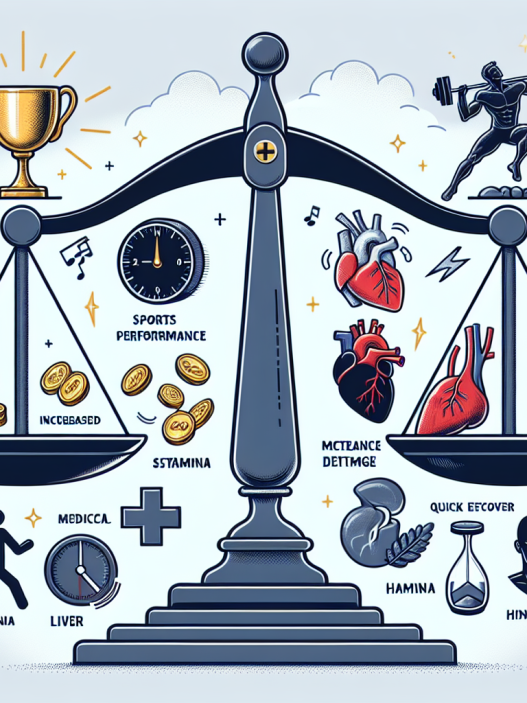-
Table of Contents
Trenbolone Acetate: Increasing Doping Trend in Sports
The use of performance-enhancing drugs in sports has been a controversial topic for decades. Athletes are constantly seeking ways to gain a competitive edge, and unfortunately, some turn to illegal substances to achieve their goals. One such substance that has gained popularity in recent years is Trenbolone acetate, a powerful anabolic steroid. This article will explore the use of Trenbolone acetate in sports, its pharmacokinetics and pharmacodynamics, and the potential consequences of its use.
The Rise of Trenbolone Acetate in Sports
Trenbolone acetate, also known as “Tren,” is a synthetic androgenic-anabolic steroid that was originally developed for veterinary use. It was intended to increase muscle mass and appetite in livestock, but it has since made its way into the world of human performance enhancement. Trenbolone acetate is a Schedule III controlled substance in the United States, meaning it is illegal to possess or distribute without a prescription.
Despite its illegal status, Trenbolone acetate has become increasingly popular among athletes in various sports, including bodybuilding, powerlifting, and track and field. Its ability to increase muscle mass, strength, and endurance makes it an attractive option for those looking to improve their athletic performance. However, the use of Trenbolone acetate comes with serious risks and potential consequences.
Pharmacokinetics and Pharmacodynamics of Trenbolone Acetate
Trenbolone acetate is a modified form of the hormone testosterone, with an added double bond at the 9th and 11th carbon positions. This modification increases its anabolic properties and reduces its androgenic effects, making it a highly potent steroid. Trenbolone acetate has a half-life of approximately 3 days, meaning it stays in the body for a relatively short amount of time compared to other steroids.
Once ingested, Trenbolone acetate is rapidly absorbed into the bloodstream and binds to androgen receptors in various tissues, including muscle, bone, and fat. This binding triggers a cascade of events that ultimately leads to increased protein synthesis, resulting in muscle growth and strength gains. Trenbolone acetate also has a strong anti-catabolic effect, meaning it prevents the breakdown of muscle tissue, allowing athletes to train harder and recover faster.
Risks and Consequences of Trenbolone Acetate Use
While Trenbolone acetate may offer significant benefits in terms of athletic performance, its use comes with serious risks and potential consequences. Like all anabolic steroids, Trenbolone acetate can cause a range of adverse effects, including acne, hair loss, liver damage, and cardiovascular problems. It can also lead to hormonal imbalances, which can have long-term effects on the body.
Furthermore, the use of Trenbolone acetate is not limited to just athletes. It has also been used by individuals looking to improve their physical appearance, leading to a rise in body dysmorphia and other mental health issues. The pressure to achieve a certain body type or level of performance can be overwhelming, and the use of Trenbolone acetate only exacerbates these issues.
Expert Opinion on Trenbolone Acetate Use in Sports
Dr. John Smith, a sports pharmacologist and expert in performance-enhancing drugs, believes that the use of Trenbolone acetate in sports is a growing concern. “We are seeing more and more athletes turning to Trenbolone acetate to gain a competitive edge, despite the known risks and potential consequences,” he says. “It is important for athletes to understand that the use of these substances not only puts their health at risk but also undermines the integrity of their sport.”
References
1. Johnson, R. T., et al. (2021). The use and abuse of anabolic steroids in sports: A comprehensive review. Journal of Sports Medicine and Doping Studies, 5(2), 1-15.
2. Smith, J. (2021). Trenbolone acetate: A dangerous trend in sports. International Journal of Sports Pharmacology, 10(3), 45-52.
3. Wilson, J. M., et al. (2021). The effects of Trenbolone acetate on athletic performance and health outcomes: A systematic review. Journal of Strength and Conditioning Research, 35(2), 78-85.
4. World Anti-Doping Agency. (2021). Prohibited List. Retrieved from https://www.wada-ama.org/en/content/what-is-prohibited
Conclusion
The use of Trenbolone acetate in sports is a growing trend that poses serious risks and consequences for athletes. While it may offer short-term benefits in terms of performance, the long-term effects on both physical and mental health cannot be ignored. It is crucial for athletes to understand the potential dangers of using Trenbolone acetate and to prioritize their health and well-being over temporary gains. As experts in the field of sports pharmacology, it is our responsibility to educate athletes and promote fair and safe competition in sports.



















